

Compact Muon Solenoid
LHC, CERN
| CMS-FSQ-15-002 ; CERN-PH-EP-2015-271 | ||
| Measurement of long-range near-side two-particle angular correlations in pp collisions at $\sqrt{s} =$ 13 TeV | ||
| CMS Collaboration | ||
| 11 October 2015 | ||
| Phys. Rev. Lett. 116 (2016) 172302 | ||
| Abstract: Results on two-particle angular correlations for charged particles produced in pp collisions at a center-of-mass energy of 13 TeV are presented. The data were taken with the CMS detector at the LHC and correspond to an integrated luminosity of about 270 inverse-nanobarns. The correlations are studied over a broad range of pseudorapidity ($| \eta | <$ 2.4) and over the full azimuth ($\phi$) as a function of charged particle multiplicity and transverse momentum ($p_{\mathrm{T}}$). In high-multiplicity events, a long-range ($ | \Delta\eta | >$ 2.0), near-side ($\Delta\phi\approx$ 0) structure emerges in the two-particle $\Delta\eta$-$\Delta\phi$ correlation functions. The magnitude of the correlation exhibits a pronounced maximum in the range 1.0 $ < p_{\mathrm{T}} < $ 2.0 GeV/$c$ and an approximately linear increase with the charged particle multiplicity. The overall correlation strength at $\sqrt{s} =$ 13TeV is similar to that found in earlier pp data at $\sqrt{s} =$ 7 TeV, but is measured up to much higher multiplicity values. The observed long-range correlations are compared to those seen in pp, pPb, and PbPb collisions at lower collision energies. | ||
| Links: e-print arXiv:1510.03068 [hep-ex] (PDF) ; CDS record ; inSPIRE record ; HepData record ; CADI line (restricted) ; | ||
| Figures | |
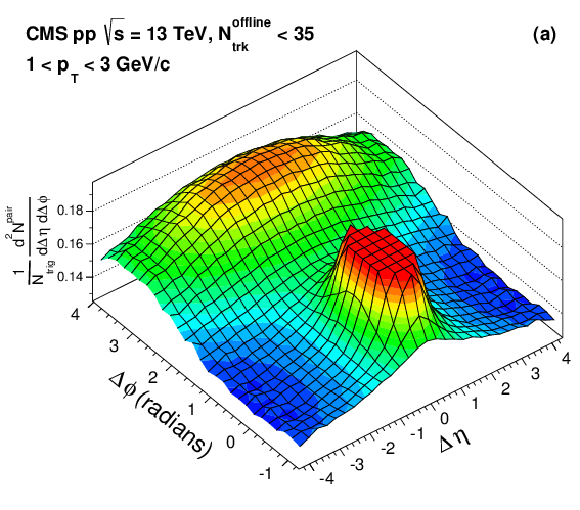
png pdf |
Figure 1-a:
The 2D $( {\Delta \eta }, {\Delta \phi })$ two-particle correlation functions in pp collisions at $ {\sqrt {s}}=$ 13 TeV for pairs of charged particles both in the range 1 $< {p_{\mathrm {T}}} <$ 3 GeV/$c$. Results are shown for (a)low-multiplicity events ($ {N_\text {trk}^\text {offline}} <$ 35) and for (b)a high-multiplicity sample ($ {N_\text {trk}^\text {offline}} \geq$ 105). The sharp peaks from jet correlations around $( {\Delta \eta }, {\Delta \phi }) = (0, 0)$ are truncated to better illustrate the long-range correlations. |
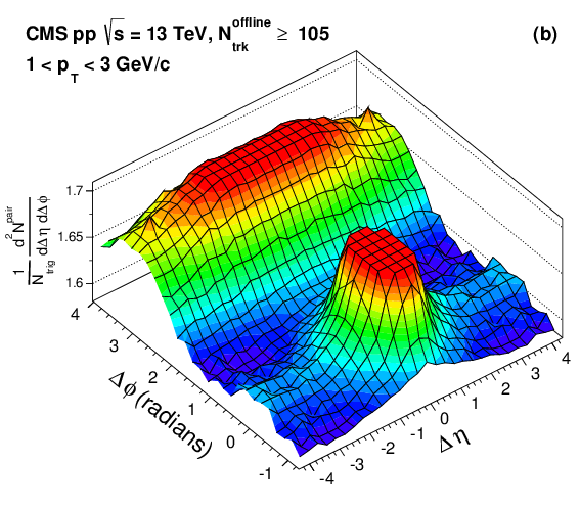
png pdf |
Figure 1-b:
The 2D $( {\Delta \eta }, {\Delta \phi })$ two-particle correlation functions in pp collisions at $ {\sqrt {s}}=$ 13 TeV for pairs of charged particles both in the range 1 $< {p_{\mathrm {T}}} <$ 3 GeV/$c$. Results are shown for (a)low-multiplicity events ($ {N_\text {trk}^\text {offline}} <$ 35) and for (b)a high-multiplicity sample ($ {N_\text {trk}^\text {offline}} \geq$ 105). The sharp peaks from jet correlations around $( {\Delta \eta }, {\Delta \phi }) = (0, 0)$ are truncated to better illustrate the long-range correlations. |
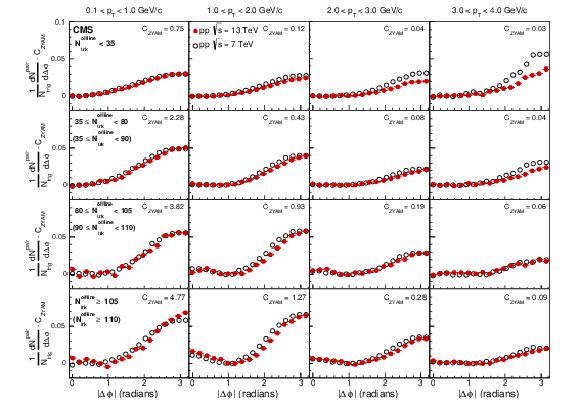
png pdf |
Figure 2:
Correlated yield obtained with the ZYAM procedure as a function of $ {| {\Delta \phi } | }$, averaged over 2 $< {| {\Delta \eta } | }<$ 4 in different ${p_{\mathrm {T}}} $ and multiplicity bins for pp data at $ {\sqrt {s}}=$ 13 TeV (filled circles) and 7 TeV (open circles). The $ {p_{\mathrm {T}}} $ selection applies to both particles in the pair. Numbers in brackets indicate the multiplicity range of the 7 TeV data when different from that at 13 TeV. The statistical uncertainties are smaller than the marker size. The subtracted ZYAM constant is given in each panel ($C_\mathrm {ZYAM}$). |
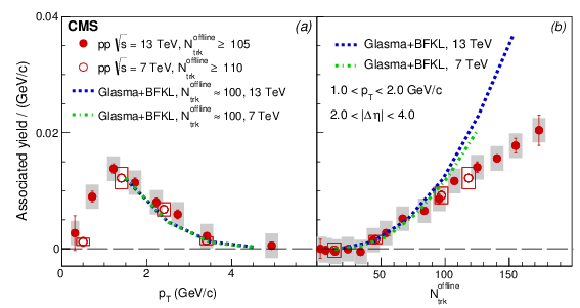
png pdf |
Figure 3:
Associated yield for the near side of the correlation function averaged over 2 $< {| {\Delta \eta } | }<$ 4 and integrated over the region $ {| {\Delta \phi } | } < \Delta \phi _\mathrm {ZYAM}$ for pp data at $ {\sqrt {s}}=$ 13 TeV (filled circles) and 7 TeV (open circles). Panel (a) shows the associated yield as a function of $ {p_{\mathrm {T}}} $ for events with $ {N_\text {trk}^\text {offline}} \geq$ 105. The $ {p_{\mathrm {T}}} $ value for each $ {p_{\mathrm {T}}} $ bin is the average $ {p_{\mathrm {T}}} $ value. In panel (b) the associated yield for 1 $< {p_{\mathrm {T}}} <$ 2 GeV/$c$ is shown as a function of multiplicity $ {N_\text {trk}^\text {offline}} $. The $ {N_\text {trk}^\text {offline}} $ value for each $ {N_\text {trk}^\text {offline}} $ bin is the average $ {N_\text {trk}^\text {offline}} $ value. The $ {p_{\mathrm {T}}} $ selection applies to both particles in each pair. The error bars correspond to the statistical uncertainties, while the shaded areas and boxes denote the systematic uncertainties. Curves represent calculations from the gluon saturation model [39]. |
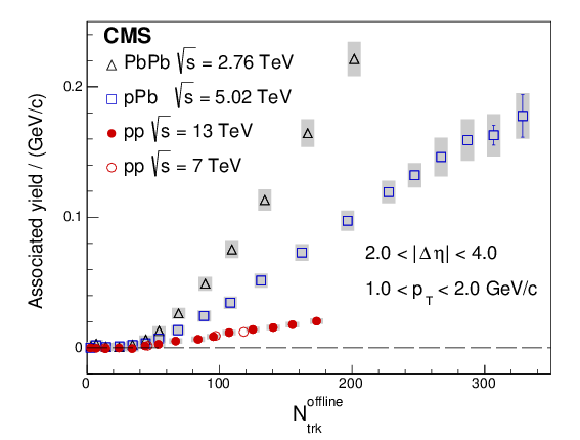
png pdf |
Figure 4:
Associated yield of long-range near-side two-particle correlations for 1 $< {p_{\mathrm {T}}} <$ 2 GeV/$c$ in pp collisions at $ {\sqrt {s}}=$ 13 and 7 TeV, pPb collisions at $ {\sqrt {s_{_\mathrm {NN}}}}=$ 5.02 TeV, and PbPb collisions at $ {\sqrt {s_{_\mathrm {NN}}}}= $ 2.76 TeV. Associated yield for the near-side of the correlation function is averaged over 2 $< {| {\Delta \eta } | }<$ 4 and integrated over the region $ {| {\Delta \phi } | } < \Delta \phi _\mathrm {ZYAM}$. The $ {N_\text {trk}^\text {offline}} $ value for each $ {N_\text {trk}^\text {offline}} $ bin is the average $ {N_\text {trk}^\text {offline}} $ value. The error bars correspond to the statistical uncertainties, while the shaded areas denote the systematic uncertainties. Note that there are PbPb points above the upper vertical scale, which are not shown for clarity. |
| Tables | |

png pdf |
Table 1:
Multiplicity classes used in the analysis, corresponding fraction of the full event sample, observed and corrected average charged particle multiplicities for $ {| \eta | }<$ 2.4 and $ {p_{\mathrm {T}}} >$ 0.4 GeV/$c$. Systematic uncertainties are given for the corrected multiplicities. |
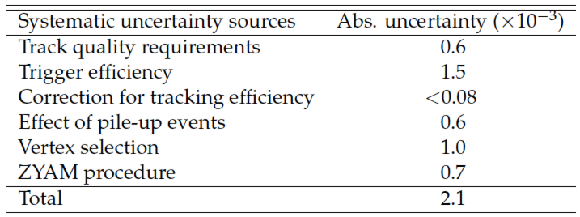
png pdf |
Table 2:
Summary of systematic uncertainties on the long-range, near-side associated yields in pp collisions at $ {\sqrt {s}}= $ 13 TeV. |
| Summary |
| In summary, two-particle angular correlations in pp collisions at $\sqrt{s} =$ 13 TeV have been measured by the CMS experiment at the LHC. The amount of data recorded corresponds to an integrated luminosity of about 270 nb$^{-1}$. As it was first observed in pp collisions at $\sqrt{s} =$ 7 TeV, two-particle azimuthal correlations in high-multiplicity pp collisions exhibit a long-range structure in the near side ($ \Delta \phi \approx 0$) extending over at least 4 units in pseudorapidity separation. The effect is most evident in the intermediate transverse momentum region between 1 and 2 GeV/$c$. The near-side long-range yield obtained with the ZYAM procedure is found to be consistent with zero in the low-multiplicity region, with an approximately linear increase with multiplicity for $N^{\rm offline}_{\rm trk} \geq $ 40. A strong collision system size dependence is observed when comparing data from pp, pPb, and PbPb collisions. Comparing the pp data at $\sqrt{s} =$ 7 TeV and 13 TeV, no collision energy dependence of the near-side associated yields is observed over the overlapping event multiplicity and $p_{\mathrm{T}}$ ranges. |

|
Compact Muon Solenoid LHC, CERN |

|

|

|

|

|

|